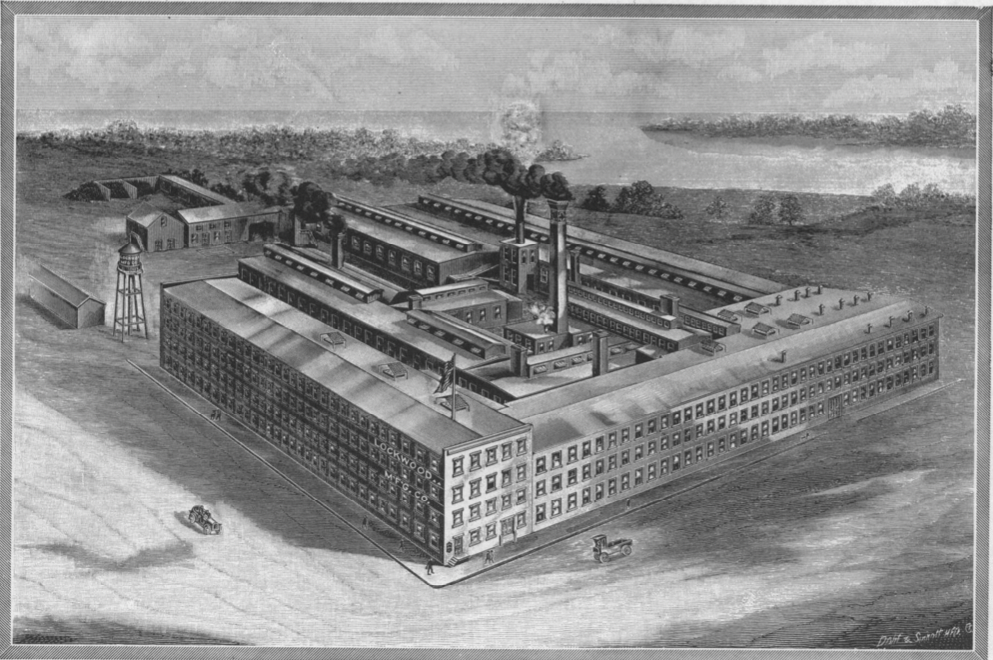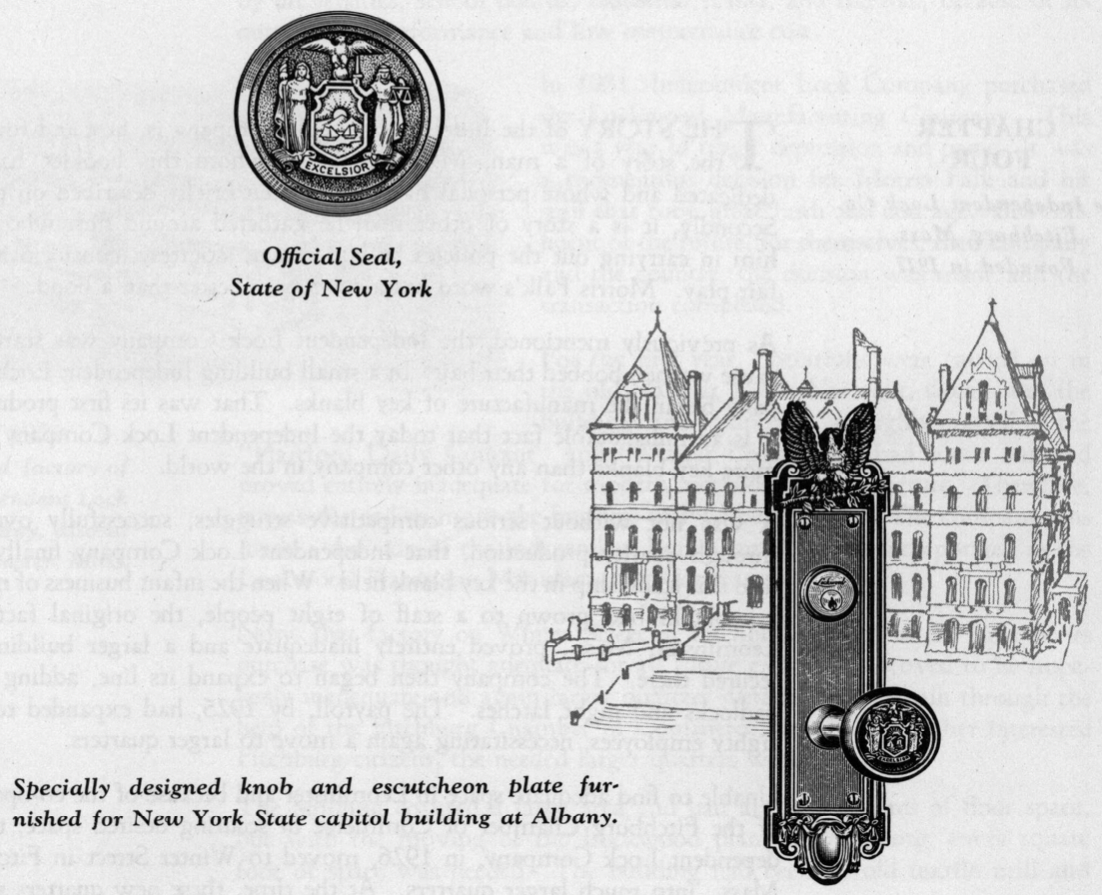Note: The following is a republished excerpt from the Lockwood Hardware Manufacturing Company’s Lockwood – The story of its past, the basis for its future. Published in 1953, and based almost entirely off of literature produced for Lockwood’s 1952 sales convention, it recounts the history of the Lockwood Hardware Manufacturing Company from 1834 until 1952.
By 1953, the Lockwood Hardware Manufacturing Company, then a division of the Independent Lock Company with both being headquartered in Fitchburg, Massachusetts, fielded branch offices in New York City, Philadelphia, Baltimore, Chicago, and Selma, Alabama along with five manufacturing plants in Fitchburg and one in Selma.
We have made no changes to this excerpt and what you see is exactly how it was printed in 1953, albeit in a different medium.
Chapter Three, The Lockwood Manufacturing Company 1910 to 1931
IN THIS CHAPTER is recorded the real rise and fall of the old Lock Company as a factor in the builders’ hardware field of the period from 1910 to 1931. Like the old Nashua Lock Company reported in Chapter One, Lockwood Manufacturing Company of South Norwalk, Conn., had its successes and, in later years, its disappointments and final sale to a stronger organization.
By 1910, Lockwood was well established in the builders’ hardware industry. The extensive line, then being marketed, can be well visualized when we find, in the year 1814, a new catalog being published having over 700 pages. While it is probably true, stock hardware sales was the predominating part of the business, it is also true, Lockwood had become very much of a factor in the contract field. In those days, it was customary for manufacturers and distributors alike to maintain a fine sample room. When a large contract was to be let, the factory provided huge trunks of hardware samples to be displayed.
Unfortunately, many of the early records of contract jobs were not preserved, or if so, they were not transferred to the Independent Lock Company. From what meager information we do have, however, we know that Lockwood hardware was supplied on some of the outstanding buildings in the country during this period, many of which are still standing. Some of them were:
THE AUDITORIUM, Los Angeles, California
U.S. POST OFFICE & COURT HOUSE, Los Angeles, California
HIGH SCHOOL BUILDING, Sacramento, California
ST. FRANCIS HOTEL, San Francisco, California
U.S. TREASURY BUILDING, San Francisco, California
THE PENINSULA HOTEL, San Mateo, California
THE HAMILTON HOTEL, Washington D.C.
MASONIC TEMPLE, Jacksonville, Florida
ST. PAUL’S EPISCOPAL CHURCH, Atlanta, Georgia
ROCHAMBEAU APARTMENTS, Baltimore, Maryland
THE SOUTHERN HOTEL, Baltimore, Maryland
HORTICULTURAL HALL, Boston, Massachusetts
TECHNOLOGY CHAMBERS, Boston, Massachusetts
THE AUDITORIUM, St. Paul, Minnesota
FIRST PRESBYTERIAN CHURCH, Kansas City, Missouri
VICTOR BUILDING, Kansas City, Missouri
STATE SAVINGS BANK BUILDING, Butte, Montana
THE STATE CAPITOL, Albany, New York
ST. GEORGE HOTEL, Brooklyn, New York
71st REGIMENT ARMORY, New York, New York
THE WORLD’S TOWER BUILDING, New York, New York
HOTEL SYRACUSE, Syracuse, New York
U.S. POST OFFICE BUILDING, Dayton, Ohio
STOCK EXCHANGE, Philadelphia, Pennsylvania
Y.M.C.A., Philadelphia, Pennsylvania
PUBLIC LIBRARY, Salt Lake City, Utah
RANDOLPH – MACON WOMEN’S COLLEGE, Lynchburg, Virginia
Many of the buildings on which Lockwood hardware was used were Government buildings. In this field, Lockwood earned an outstanding reputation as.a supplier of finishing hardware for post offices all over the United States.
That Lockwood excelled in fine craftsmanship is evidenced by a special cast design bearing the seal of the State of New York and supplied for the additions to the State Capitol in Albany, during the early part of this period. Since the close of World War II, the old capitol building has been completely remodeled and again Lockwood was called upon to reproduce this same design with the same degree of skill and workmanship evident in the earlier product.

Lockwood Manufacturing Company plant at South Norwalk, Conn. From a wood cut in the 700 page Lockwood catalog of 1914.
Truly a red letter day of this era was the opening of the Holland Tunnel, built during the latter part of the period. A large advertisement, appearing in the New York Times of that day, proclaimed the fact to all the world that it was equipped with Lockwood hardware. Lockwood Hardware was installed on the Atlantic Refining Company office building in Philadelphia, and their service stations from Maine to Florida, during this period. The Kelley Springfield Plant at Cumberland, Maryland, was also Lockwood equipped.
From the beginning of the Lockwood Manufacturing Company in 1888 until his death in 1926, Henry Lockwood was the motivating force behind it’s growth and development. When Henry Lockwood spoke, it was done. Every morning he made a tour of the factory, visiting every department. With Henry Lockwood’s passing there came a period of inertia, then decline, much the same as we found in the Nashua Lock Company one half century before. Though new blood was brought into the company, it was too late. The die was cast. For the second time we find the business being surrendered to others.


